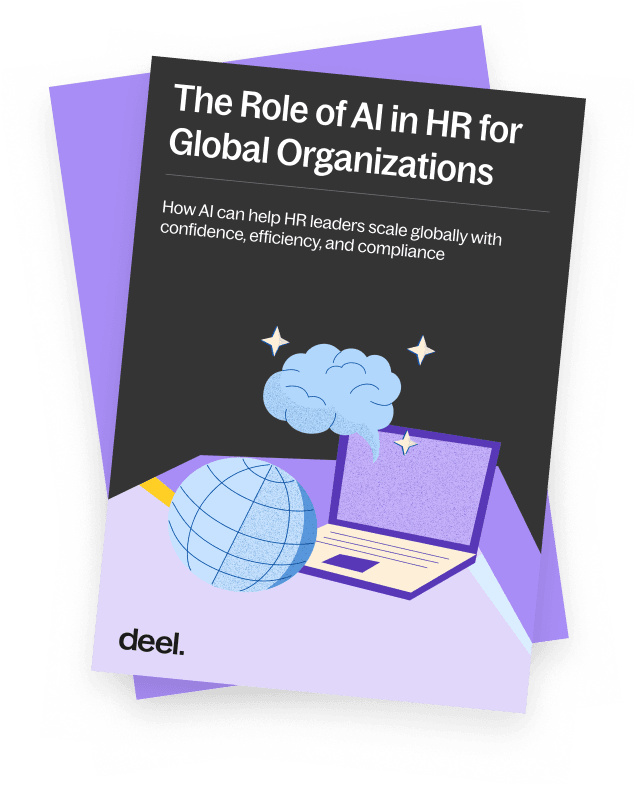Article
2 min read
Level-Up Hiring with AI: 7 Playbook Moves to Trial Today
Global HR
Global hiring

Author
Alan Price
Last Update
June 17, 2025

Table of Contents
1. Treat AI as an assistant, not “the recruiter”
2. Use AI to improve the candidate experience
3. Build the new craft skills: Prompting plus judgment calls
5. Turn interview notes into talent intelligence
6. Set the right expectations with executives
7. Start narrow: One workflow, one tool, one KPI
AI will reshape more than TA. Plan for that now
Alan Price is an experienced international talent acquisition leader, having led People & Talent Acquisition teams for some of the largest technology companies like Uber and Google. At Deel, as the Director of Talent Acquisition he oversees talent acquisition teams in the US, LATAM, EMEA, and APAC regions.
If you’re in Talent Acquisition, you’ve likely seen the hype, hot takes, and headlines about AI. But here’s the reality I’m working with: AI is already changing how we hire, and the smartest recruiting teams aren’t waiting for perfect conditions. They’re piloting, testing, and compounding wins now.
This guide isn’t about theory. It’s a practical playbook drawn from my own experience leading Talent Acquisition at Deel, a high-growth, global company predicted to receive 1.8 million job applications this year alone. These are tools and workflows you can trial this quarter without putting compliance, candidate experience, or your team’s sanity at risk.
Preamble: Not all AI is created equal
But first, let’s define what kind of AI we’re discussing here. We can break it down into three categories:
- Assistive AI supports recruiters with tasks like screening resumes, scheduling interviews, and summarizing calls. In this area, I see the fastest ROI: fewer admin hours translate into more bandwidth for strategic work.
- Predictive AI can help forecast time-to-fill or surface conversion trends, but only if your underlying data is clean and structured.
- Selective AI is where the legal and ethical complexity ramps up — this includes tools that auto-rank or reject candidates without human oversight. I treat these with extreme caution, especially with new laws like NYC Local Law 144 and the EU AI Act in play.
For most hiring teams, the best place to start is with assistive AI. Here’s how.
1. Treat AI as an assistant, not “the recruiter”
The most significant ROI right now comes from using AI to remove busywork, not to replace judgment. Think of tools that auto-summarize interviews, parse resumes for skills, or handle timezone-chasing for scheduling.
Try this: Record a screening call with an AI scribe (like MetaView or Otter), then drop the summary into your ATS. Share it with the hiring manager, and you’ve just saved time and improved collaboration.
2. Use AI to improve the candidate experience
AI isn’t just about recruiter efficiency. When used well, it helps you respond to more applicants faster and fairly. That means less ghosting, more thoughtful rejections, and a better experience for everyone, even those you don’t hire.
Try this: Set up AI tools to flag strong profiles instead of auto-rejecting. This creates a broader top-of-funnel while keeping human review in place. The result is better coverage without compromising quality.
3. Build the new craft skills: Prompting plus judgment calls
AI can draft outreach, structure interview guides, and even identify potential red flags, but it’s only as good as the prompts and decisions behind it. The real skill for recruiters is knowing how to steer AI and when to step in.
Here are some prompts you can test:
- “Write a passive-candidate outreach message for a [role]. Use first-person voice, include one team or product hook, and close with a light CTA.”
- “Summarize this interview into a one-paragraph snapshot. Focus on role fit, standout signals, and any concerns. Make it decision-ready.”
- “Draft a rejection email for a finalist candidate. Keep it kind, clear, and constructive. Include helpful feedback, but stay compliant.”
4. Automate screening, not selection
Laws like NYC Local Law 144 and the EU AI Act are clear. If AI makes or influences hiring decisions, it needs transparency and auditability. That’s why keeping the final call in human hands is critical.
Try this instead: Let your ATS’s AI highlight top matches, but make the shortlisting and disposition steps manual. Document your decision process so you have all documentation available for compliance purposes.
5. Turn interview notes into talent intelligence
Recruiting teams have a goldmine of qualitative data, including salary expectations, career goals, and work preferences. With AI, that data can finally be structured and shared to inform workforce planning.
Try this: Export your past month’s interview summaries. Use a keyword tool to cluster trends by skill, location, or compensation expectations. Then, build a one-pager for Finance or your People team to feed into next quarter’s headcount plan.
6. Set the right expectations with executives
Execs often hear “AI” and immediately think “cost savings.” But the real value, especially early on, is in time saved and speed gained, not in replacing headcount.
Frame it this way: Track metrics like recruiter hours saved, days-to-offer, and candidate NPS on a pilot role. Share the before/after in your next ops meeting. It’s a straightforward, concrete way to make the case for scaling AI across your funnel.
7. Start narrow: One workflow, one tool, one KPI
You don’t need a full transformation project to start using AI. In fact, the most successful teams start small: automating one painful step, proving value fast, and then expanding from there.
Try this: Map your hiring funnel and circle the step(s) slowing you down the most. Maybe it’s deduplicating resumes or writing feedback summaries. Pilot an AI tool there for 30 days, track one KPI, and iterate from there.
AI will reshape more than TA. Plan for that now
Hiring with AI isn’t about gimmicks or silver bullets. It’s about using automation to remove friction so recruiters can do what they do best: assess, connect, and advise.
Clean data, thoughtful prompts, and clear compliance guardrails are the new table stakes. The sooner you start testing, the sooner you’ll find what works and what doesn’t.
The age of AI in recruiting isn’t coming. It’s already here. The question is whether your team is testing first-round pilots or still building the business case.

Disclaimer: The content provided is intended solely for informational purposes and should not be construed as legal or hiring advice. Consult a professional before proceeding.

Alan Price serves as the Director of Talent Acquisition at Deel, overseeing talent acquisition teams in the US, LATAM, EMEA, and APAC regions. Before joining Deel, Alan was a founding member of the micro-mobility company Dott, where he held the position of Vice President of People. Prior to his role at Dott, he held senior positions at Uber and Google.













